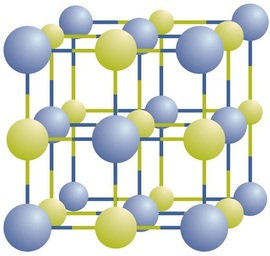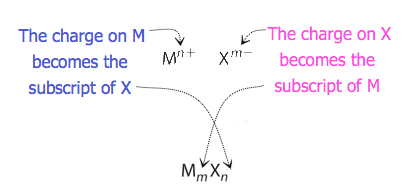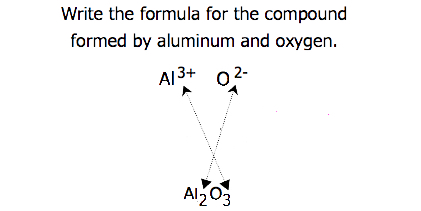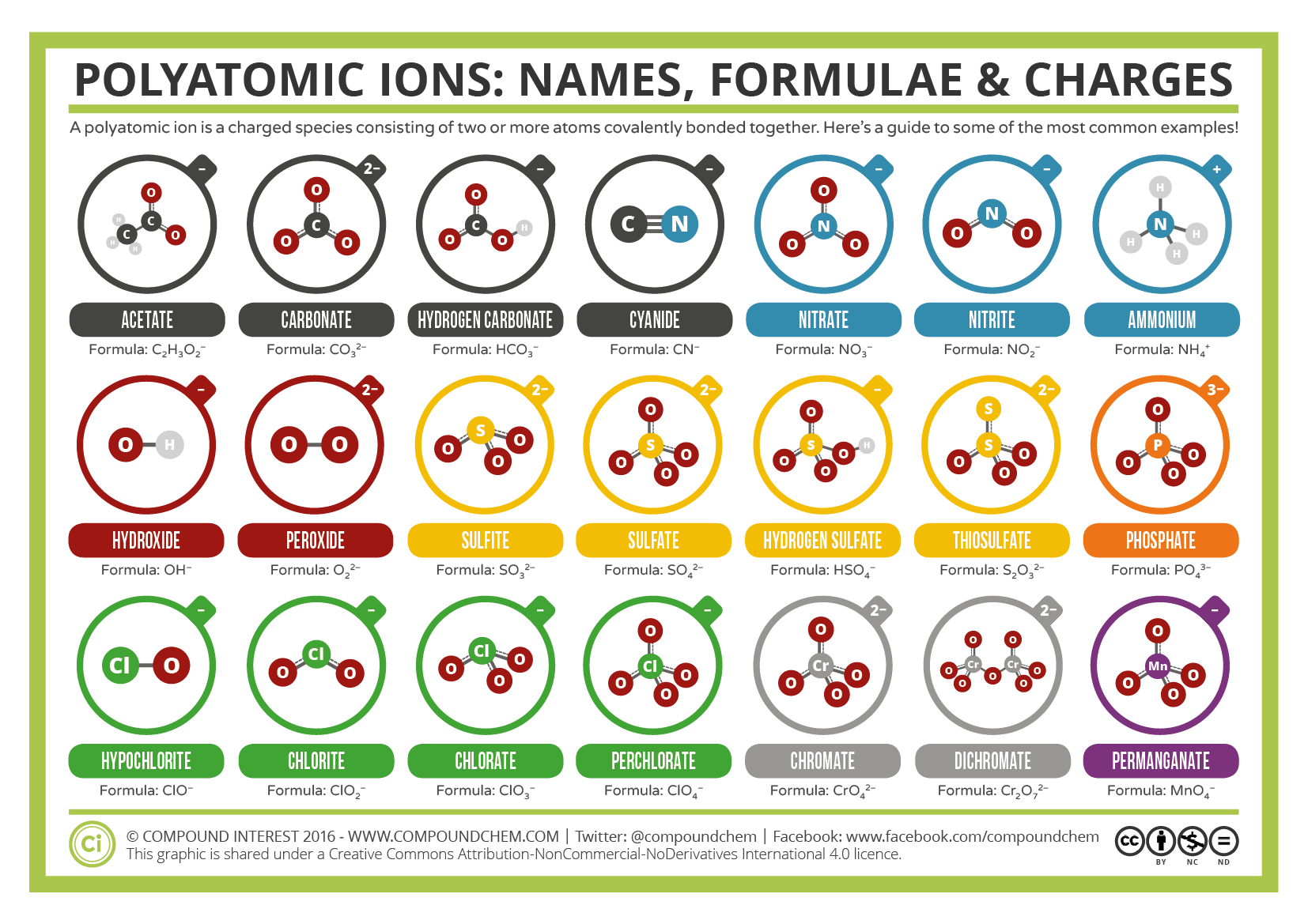Lithium And Bromine Ionic Compound
iii.3: Formulas for Ionic Compounds
- Page ID
- 165434
- Write the chemical formula for a elementary ionic compound.
- Recognize polyatomic ions in chemic formulas.
We have already encountered some chemical formulas for uncomplicated ionic compounds. A chemic formula is a concise list of the elements in a chemical compound and the ratios of these elements. To better sympathise what a chemical formula means, we must consider how an ionic compound is synthetic from its ions.
Ionic compounds exist as alternate positive and negative ions in regular, three-dimensional arrays called crystals (Figure \(\PageIndex{1}\)). Equally you can see, there are no private \(\ce{NaCl}\) "particles" in the array; instead, there is a continuous lattice of alternating sodium and chloride ions. Still, we tin can use the ratio of sodium ions to chloride ions, expressed in the everyman possible whole numbers, as a manner of describing the chemical compound. In the example of sodium chloride, the ratio of sodium ions to chloride ions, expressed in lowest whole numbers, is 1:i, so we use \(\ce{NaCl}\) (one \(\ce{Na}\) symbol and one \(\ce{Cl}\) symbol) to represent the compound. Thus, \(\ce{NaCl}\) is the chemical formula for sodium chloride, which is a concise way of describing the relative number of unlike ions in the chemical compound. A macroscopic sample is composed of myriads of NaCl pairs; each private pair called a formula unit. Although it is convenient to retrieve that \(\ce{NaCl}\) crystals are composed of individual \(\ce{NaCl}\) units, Effigy \(\PageIndex{1}\) shows that no unmarried ion is exclusively associated with whatever other single ion. Each ion is surrounded past ions of contrary charge.

The formula for an ionic compound follows several conventions. First, the cation is written earlier the anion. Because well-nigh metals form cations and most nonmetals form anions, formulas typically list the metal get-go so the nonmetal. Second, charges are not written in a formula. Remember that in an ionic compound, the component species are ions, not neutral atoms, fifty-fifty though the formula does non comprise charges. Finally, the proper formula for an ionic compound always has a net zippo charge, meaning the total positive charge must equal the total negative accuse. To make up one's mind the proper formula of any combination of ions, determine how many of each ion is needed to balance the total positive and negative charges in the chemical compound.
This rule is ultimately based on the fact that matter is, overall, electrically neutral.
By convention, assume that there is but 1 atom if a subscript is not present. We do not use 1 as a subscript.
If we look at the ionic compound consisting of lithium ions and bromide ions, nosotros see that the lithium ion has a 1+ accuse and the bromide ion has a i− accuse. Only i ion of each is needed to balance these charges. The formula for lithium bromide is \(\ce{LiBr}\).
When an ionic chemical compound is formed from magnesium and oxygen, the magnesium ion has a 2+ accuse, and the oxygen atom has a 2− accuse. Although both of these ions have college charges than the ions in lithium bromide, they still balance each other in a one-to-one ratio. Therefore, the proper formula for this ionic compound is \(\ce{MgO}\).
Now consider the ionic compound formed past magnesium and chlorine. A magnesium ion has a 2+ accuse, while a chlorine ion has a 1− accuse:
\[\ce{Mg^{2+}Cl^{−}} \nonumber \]
Combining one ion of each does not completely remainder the positive and negative charges. The easiest manner to balance these charges is to assume the presence of two chloride ions for each magnesium ion:
\[\ce{Mg^{ii+} Cl^{−} Cl^{−}} \nonumber \]
Now the positive and negative charges are balanced. We could write the chemical formula for this ionic compound as \(\ce{MgClCl}\), simply the convention is to use a numerical subscript when in that location is more than than one ion of a given type—\(\ce{MgCl2}\). This chemic formula says that there are one magnesium ion and two chloride ions in this formula. (Do non read the "Cl2" function of the formula every bit a molecule of the diatomic elemental chlorine. Chlorine does not exist as a diatomic element in this chemical compound. Rather, it exists as two private chloride ions.) By convention, the lowest whole number ratio is used in the formulas of ionic compounds. The formula \(\ce{Mg2Cl4}\) has balanced charges with the ions in a 1:2 ratio, simply information technology is not the lowest whole number ratio.
By convention, the lowest whole-number ratio of the ions is used in ionic formulas. There are exceptions for sure ions, such as \(\ce{Hg2^{2+}}\).
For compounds in which the ratio of ions is not as obvious, the subscripts in the formula can exist obtained by crossing charges: use the accented value of the charge on one ion as the subscript for the other ion. This method is shown schematically in Effigy 3.3.2.


When crossing charges, it is sometimes necessary to reduce the subscripts to their simplest ratio to write the empirical formula. Consider, for example, the compound formed past Pb4 + and Otwo−. Using the accented values of the charges on the ions as subscripts gives the formula Pb2 O4 . This simplifies to its correct empirical formula PbO2 . The empirical formula has ane Pbiv + ion and two O2− ions.
Write the chemic formula for an ionic chemical compound composed of each pair of ions.
- the sodium ion and the sulfur ion
- the aluminum ion and the fluoride ion
- the 3+ iron ion and the oxygen ion
Solution
- To obtain a valence shell octet, sodium forms an ion with a 1+ charge, while the sulfur ion has a 2− charge. 2 sodium i+ ions are needed to remainder the two− charge on the sulfur ion. Rather than writing the formula as \(\ce{NaNaS}\), we shorten information technology past convention to \(\ce{Na2S}\).
- The aluminum ion has a 3+ charge, while the fluoride ion formed by fluorine has a ane− charge. Iii fluorine 1− ions are needed to balance the three+ accuse on the aluminum ion. This combination is written as \(\ce{AlF3}\).
- Iron tin class ii possible ions, merely the ion with a 3+ charge is specified hither. The oxygen atom has a 2− accuse equally an ion. To residual the positive and negative charges, we look to the least common multiple—6: ii atomic number 26 three+ ions will requite 6+, while three 2− oxygen ions will give 6−, thereby balancing the overall positive and negative charges. Thus, the formula for this ionic compound is \(\ce{Fe2O3}\). Alternatively, use the crossing charges method shown in Effigy iii.3.2.
Write the chemical formula for an ionic compound composed of each pair of ions.
- the calcium ion and the oxygen ion
- the 2+ copper ion and the sulfur ion
- the 1+ copper ion and the sulfur ion
- Answer a:
-
CaO
- Answer b:
-
CuS
- Respond c:
-
Cu2Southward
Polyatomic Ions
Some ions consist of groups of atoms covalently bonded together and have an overall electric accuse. Because these ions comprise more than i atom, they are called polyatomic ions. The Lewis structures, names and formulas of some polyatomic ions are found in Table iii.3.one.

Table \(\PageIndex{ane}\): Some Polyatomic Ions
Polyatomic ions have divers formulas, names, and charges that cannot exist modified in any style. Table \(\PageIndex{2}\) lists the ion names and ion formulas of the most common polyatomic ions. For example, \(\ce{NO3^{−}}\) is the nitrate ion; it has one nitrogen cantlet and 3 oxygen atoms and an overall one− charge. Figure \(\PageIndex{ii}\) lists the most common polyatomic ions.
| Ion Name | Ion Formula |
|---|---|
| ammonium ion | NHfour +1 |
| hydroxide ion | OH−1 |
| cyanide ion | CN−1 |
| carbonate ion | CO3 −two |
| bicarbonate or hydrogen carbonate | HCO3 − |
| acetate ion | CiiH3Oii −one or CH3CO2 −1 |
| nitrate ion | NOthree −1 |
| nitrite ion | NOtwo −ane |
| sulfate ion | SOfour −two |
| sulfite ion | SO3 −ii |
| phosphate ion | POfour −iii |
| phosphite ion | PO3 −3 |
Note that just i polyatomic ion in this Table, the ammonium ion (NH4 +ane), is a cation. This polyatomic ion contains one nitrogen and 4 hydrogens that collectively bear a +i charge. The remaining polyatomic ions are all negatively-charged and, therefore, are classified as anions. Yet, only 2 of these, the hydroxide ion and the cyanide ion, are named using the "-ide" suffix that is typically indicative of negatively-charged particles. The remaining polyatomic anions, which all incorporate oxygen, in combination with another non-metal, exist every bit part of a series in which the number of oxygens within the polyatomic unit tin vary. Equally has been repeatedly emphasized in several sections of this text, no ii chemical formulas should share a common chemic proper noun. A unmarried suffix, "-ide," is insufficient for distinguishing the names of the anions in a related polyatomic series. Therefore, "-ate" and "-ite" suffixes are employed, in guild to announce that the corresponding polyatomic ions are function of a series. Additionally, these suffixes also signal the relative number of oxygens that are contained within the polyatomic ions. Notation that all of the polyatomic ions whose names terminate in "-ate" contain one more oxygen than those polyatomic anions whose names end in "-ite." Unfortunately, much similar the common system for naming transition metals, these suffixes only indicate the relative number of oxygens that are contained within the polyatomic ions. For example, the nitrate ion, which is symbolized as NO3 −1, has one more oxygen than the nitrite ion, which is symbolized as NOii −i. However, the sulfate ion is symbolized as SO4 −2. While both the nitrate ion and the sulfate ion share an "-ate" suffix, the former contains iii oxygens, simply the latter contains iv. Additionally, both the nitrate ion and the sulfite ion comprise iii oxygens, simply these polyatomic ions exercise non share a common suffix. Unfortunately, the relative nature of these suffixes mandates that the ion formula/ion proper name combinations of the polyatomic ions must simply be memorized.
The rule for constructing formulas for ionic compounds containing polyatomic ions is the same as for formulas containing monatomic (single-atom) ions: the positive and negative charges must residuum. If more than ane of a particular polyatomic ion is needed to residuum the charge, the entire formula for the polyatomic ion must exist enclosed in parentheses, and the numerical subscript is placed exterior the parentheses. This is to show that the subscript applies to the entire polyatomic ion. Two examples are shown below:

Write the chemical formula for an ionic compound equanimous of each pair of ions.
- the potassium ion and the sulfate ion
- the calcium ion and the nitrate ion
Solution
- Potassium ions have a charge of one+, while sulfate ions accept a charge of 2−. Nosotros volition demand two potassium ions to balance the charge on the sulfate ion, so the proper chemical formula is \(\ce{K_2SO_4}\).
- Calcium ions take a charge of 2+, while nitrate ions have a accuse of ane−. Nosotros will need 2 nitrate ions to residue the charge on each calcium ion. The formula for nitrate must be enclosed in parentheses. Thus, nosotros write \(\ce{Ca(NO3)2}\) as the formula for this ionic chemical compound.
Write the chemical formula for an ionic chemical compound composed of each pair of ions.
- the magnesium ion and the carbonate ion
- the aluminum ion and the acetate ion
- Respond a:
-
Mgtwo + and COthree 2 - = MgCO3
- Respond b:
-
Al3 + and CiiH3Otwo - = Al(CiiH3O2)3
Recognizing Ionic Compounds
There are two ways to recognize ionic compounds. First, compounds between metal and nonmetal elements are usually ionic. For instance, CaBrtwo contains a metallic element (calcium, a grouping 2A metal) and a nonmetallic element (bromine, a group 7A nonmetal). Therefore, it is nigh likely an ionic compound. (In fact, it is ionic.) In contrast, the compound NO2 contains two elements that are both nonmetals (nitrogen, from grouping 5A, and oxygen, from group 6A). Information technology is not an ionic compound; information technology belongs to the category of covalent compounds discuss elsewhere. Also notation that this combination of nitrogen and oxygen has no electrical charge specified, and so information technology is not the nitrite ion.
2nd, if y'all recognize the formula of a polyatomic ion in a compound, the compound is ionic. For example, if you run into the formula \(\ce{Ba(NO3)2}\), you may recognize the "NO3" part as the nitrate ion, \(\rm{NO_3^−}\). (Retrieve that the convention for writing formulas for ionic compounds is not to include the ionic accuse.) This is a clue that the other part of the formula, \(\ce{Ba}\), is actually the \(\ce{Ba^{ii+}}\) ion, with the 2+ charge balancing the overall 2− charge from the ii nitrate ions. Thus, this compound is also ionic.
Identify each compound every bit ionic or not ionic.
- \(\ce{Na2O}\)
- \(\ce{PCl3}\)
- \(\ce{NH4Cl}\)
- \(\ce{OF2}\)
Solution
- Sodium is a metal, and oxygen is a nonmetal; therefore, \(\ce{Na2O}\) is expected to exist ionic.
- Both phosphorus and chlorine are nonmetals. Therefore, \(\ce{PCl3}\) is non ionic.
- The \(\ce{NH4}\) in the formula represents the ammonium ion, \(\ce{NH4^{+}}\), which indicates that this compound is ionic.
- Both oxygen and fluorine are nonmetals. Therefore, \(\ce{OF2}\) is not ionic.
Place each chemical compound equally ionic or not ionic.
- \(\ce{N2O}\)
- \(\ce{FeCl3}\)
- \(\ce{(NH4)3PO4}\)
- \(\ce{SOCl2}\)
- Answer a:
-
not ionic
- Answer b:
-
ionic
- Respond c:
-
ionic
- Answer d:
-
not ionic
Science has long recognized that blood and seawater have similar compositions. Subsequently all, both liquids accept ionic compounds dissolved in them. The similarity may be more than than mere coincidence; many scientists recollect that the beginning forms of life on World arose in the oceans. A closer look, still, shows that blood and seawater are quite different. A 0.9% solution of sodium chloride approximates the common salt concentration found in blood. In dissimilarity, seawater is principally a iii% sodium chloride solution, over iii times the concentration in blood. Here is a comparison of the amounts of ions in blood and seawater:
| Ion | Percent in Seawater | Percentage in Blood |
|---|---|---|
| Na+ | 2.36 | 0.322 |
| Cl− | 1.94 | 0.366 |
| Mgii + | 0.xiii | 0.002 |
| Sofour 2 − | 0.09 | — |
| M+ | 0.04 | 0.016 |
| Ca2 + | 0.04 | 0.0096 |
| HCO3 − | 0.002 | 0.165 |
| HPO4 two −, HiiPOfour − | — | 0.01 |
Most ions are more abundant in seawater than they are in blood, with some important exceptions. There are far more hydrogen carbonate ions (\(\ce{HCO3^{−}}\)) in blood than in seawater. This difference is significant because the hydrogen carbonate ion and some related ions have a crucial part in controlling the acid-base properties of blood. The amount of hydrogen phosphate ions—\(\ce{HPO4^{2−}}\) and \(\ce{H2PO4^{−}}\)—in seawater is very low, but they are nowadays in college amounts in blood, where they too affect acrid-base properties. Another notable difference is that claret does not have pregnant amounts of the sulfate ion (\(\ce{SO4^{2−}}\)), but this ion is present in seawater.
Primal Takeaways
- Proper chemical formulas for ionic compounds balance the total positive charge with the total negative charge.
- Groups of atoms with an overall accuse, called polyatomic ions, likewise exist.
EXERCISES
- What information is independent in the formula of an ionic chemical compound?
- Why do the chemical formulas for some ionic compounds contain subscripts, while others do not?
3. Write the chemical formula for the ionic chemical compound formed by each pair of ions.
- Mg2 + and I−
- Na+ and O2−
4. Write the chemic formula for the ionic compound formed by each pair of ions.
- Na+ and Br−
- Mg2 + and Br−
- Mgii + and South2−
5. Write the chemical formula for the ionic compound formed past each pair of ions.
- G+ and Cl−
- Mgii + and Cl−
- Mg2 + and Se2 −
6. Write the chemical formula for the ionic compound formed past each pair of ions.
- Na+ and Nthree−
- Mgii + and Due north3−
- Al3 + and S2−
vii. Write the chemical formula for the ionic compound formed past each pair of ions.
- Li+ and N3−
- Mgii + and P3−
- Li+ and P3−
viii. Write the chemical formula for the ionic compound formed past each pair of ions.
- Atomic number 263 + and Br−
- Atomic number 262 + and Br−
- Au3 + and Due south2−
- Au+ and S2−
9. Write the chemic formula for the ionic compound formed past each pair of ions.
- Cr3 + and O2−
- Crtwo + and O2−
- Atomic number 82ii + and Cl−
- Pb4 + and Cl−
10. Write the chemic formula for the ionic compound formed past each pair of ions.
- Crthree + and NOthree −
- Fe2 + and POfour three −
- Caii + and CrO4 ii −
- Althree + and OH−
eleven. Write the chemical formula for the ionic compound formed by each pair of ions.
- NH4 + and NO3 −
- H+ and Cr2Oseven 2 −
- Cu+ and CO3 2 −
- Na+ and HCOiii −
12. For each pair of elements, make up one's mind the charge for their ions and write the proper formula for the resulting ionic compound between them.
- Ba and Southward
- Cs and I
xiii. For each pair of elements, decide the charge for their ions and write the proper formula for the resulting ionic chemical compound between them.
- K and South
- Sc and Br
14. Which compounds would you predict to be ionic?
- LitwoO
- (NH4)twoO
- COii
- FeSO3
- C6H6
- CiiHhalf-dozenO
fifteen. Which compounds would you predict to be ionic?
- Ba(OH)2
- CH2O
- NHiiCONH2
- (NH4)2CrOiv
- C8Hxviii
- NH3
Answers
i. the ratio of each kind of ion in the compound
2. Sometimes more than one ion is needed to balance the charge on the other ion in an ionic chemical compound.
three.
- MgI2
- NaiiO
4.
- NaBr
- MgBr2
- MgS
five.
- KCl
- MgClii
- MgSe
6.
- NaiiiN
- Mg3Northwardii
- Al2Sthree
7.
- LiiiiNorth
- Mg3P2
- Li3P
8.
- FeBriii
- FeBr2
- Au2S3
- Au2S
9.
- Cr2Othree
- CrO
- PbCltwo
- PbCl4
10.
- Cr(NO3)3
- Fe3(POiv)2
- CaCrOiv
- Al(OH)iii
xi.
- NH4NO3
- H2Cr2O7
- CutwoCO3
- NaHCO3
12.
- Batwo +, Sii−, BaS
- Cs+, I−, CsI
13.
- Yard+, Due southii−, M2S
- Sc3 +, Br−, ScBriii
fourteen.
- ionic
- ionic
- non ionic
- ionic
- not ionic
- not ionic
15.
- ionic
- not ionic
- not ionic
- ionic
- non ionic
- non ionic
Lithium And Bromine Ionic Compound,
Source: https://chem.libretexts.org/Courses/Windward_Community_College/BIOC_141%3A_Fundamentals_of_Biochemistry_(Colmenares_and_Ashburn)/03%3A_Ionic_Bonding_and_Simple_Ionic_Compounds/3.3%3A_Formulas_for_Ionic_Compounds
Posted by: gonzalessiquene.blogspot.com


0 Response to "Lithium And Bromine Ionic Compound"
Post a Comment